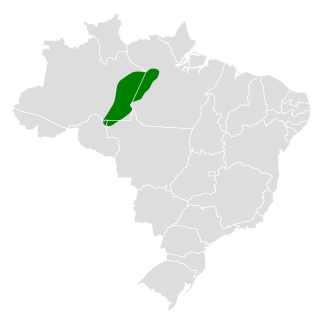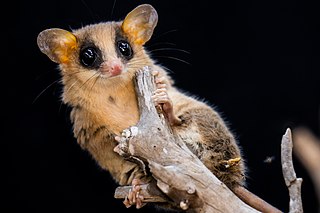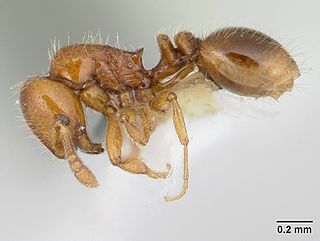Monomorium santschii is a species of ant that is native to Tunisia. The most famous species in the genus Monomorium is the highly invasive pharaoh ant, Monomorium pharaonis.

The lunulated antbird is a species of insectivorous bird in the family Thamnophilidae. It is found in Ecuador and Peru. Its natural habitat is subtropical or tropical moist lowland forests.

The white-throated antbird is a species of bird in the family Thamnophilidae. It is found in Bolivia, Brazil and Peru. Its natural habitat is subtropical or tropical moist lowland forests.

The Pale-faced bare-eye, sometimes known as the pale-faced antbird, is a species of bird in the family Thamnophilidae. It has often been placed in the monotypic genus Skutchia, but based on genetic evidence this genus is now merged with Phlegopsis, and this treatment was adopted by the SACC in 2010. It is endemic to humid forest in the south-central Amazon in Brazil. It is an obligate ant-follower only rarely seen away from ant swarms.

Gracilinanus is a genus of opossum in the family Didelphidae. It was separated from the genus Marmosa in 1989, and has since had the genera Cryptonanus, Chacodelphys, and Hyladelphys removed from it.

Phengaris rebeli, common name mountain Alcon blue, is a species of butterfly in the family Lycaenidae. It was first found and described in Styria, Austria, on Mount Hochschwab around 1700. Although it was initially classified as a subspecies of P. alcon, a European researcher, Lucien A. Berger, designated it as a separate species in 1946. Genetic similarities between P. rebeli and P. alcon have led many researchers to argue that the two are the same species and differences are due to intraspecific variation.

The Sri Lankan relict ant is a species of ant placed in a tribe of its own within the family Formicidae. The genus is monotypic, with the only species endemic to Sri Lanka, where it is known from just a few locations. It is one of the few ant species considered endangered.

Monomorium bidentatum is a species of ant in the subfamily Myrmicinae. It is endemic to two South American countries, Chile and Argentina.
Temnothorax kutteri is a species of ant in the genus Temnothorax. It is native to southern France and eastern Iberia, from the Pyrenees to the Sierra Nevada. The species parasitises other ant species in the genus Temnothorax.
Temnothorax inquilinus is a species of ant in the genus Temnothorax native to Ukraine.
Myrmecia inquilina is a species of ant endemic to Australia in the subfamily Myrmeciinae, first discovered in 1955 and described by Athol Douglas and William Brown Jr. in 1959. These ants are large, measuring 21.4 millimetres (0.84 in). During the time of its discovery, Douglas and Brown announced M. inquilina as the first social parasite among the primitive subfamilies, and today it is one of the two known Myrmecia species to have no worker caste. Two host species are known, Myrmecia nigriceps and Myrmecia vindex. Aggression between M. inquilina and its host species does not occur, and colonies may only produce M. inquilina brood months after the inquiline queens begin to lay their eggs. Queens eat the colony brood or trophic eggs, and other Myrmecia species may kill M. inquilina queens if they reject them. Due to its restricted distribution and threats to its habitat, the ant is "vulnerable" according to the IUCN Red List.

Oxyepoecus bruchi is a species of ant in the subfamily Myrmicinae. It is endemic to Argentina.

Oxyepoecus is a Neotropical genus of ant in the subfamily Myrmicinae. The genus is a member of the tribe Solenopsidini and currently includes 20 species.
Oxyepoecus daguerrei is a species of ant in the genus Oxyepoecus. It is native to Argentina.

Temnothorax americanus is a species of slave-maker ant in the genus Temnothorax. The ants are 2–3 mm in size, and endemic to the northeastern United States and adjacent Canadian regions. They do not forage for food, but instead 'scout workers' from the colony seek out nearby host colonies of ants, steal larvae and bring them back to their own colony. A small T. americanus colony could consist of a queen, two to five workers and thirty to sixty slaves.

Pseudoatta is a genus of ant in the subfamily Myrmicinae. It contains the single species Pseudoatta argentina, native to Argentina.

Tetramorium inquilinum is an ectoparasitic ant found in Europe. It was discovered by Swiss myrmecologist Heinrich Kutter. The species is unusual for lacking a worker caste, the queens and males living entirely off the care of the pavement ant. It has been called "the 'ultimate' parasitic ant" by myrmecologists Edward O. Wilson and Bert Hölldobler.

The Christmas Island shrew, also known as the Christmas Island musk-shrew is an extremely rare or possibly extinct shrew from Christmas Island. It was variously placed as subspecies of the Asian gray shrew or the Southeast Asian shrew, but morphological differences and the large distance between the species indicate that it is an entirely distinct species.
Oxyepoecus bidentatus is a Neotropical species of ant in the genus Oxyepoecus. The species is only known from workers from Paraguay.













